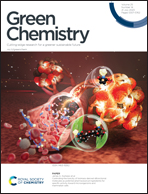Utilising bio-based plasticiser castor oil and recycled PLA for the production of conductive additive manufacturing feedstock and detection of bisphenol A†
Abstract
The production of electrically conductive additive manufacturing feedstocks from recycled poly(lactic acid) (rPLA), carbon black (CB), and bio-based plasticiser castor oil is reported herein. The filament was used to print additively manufactured electrodes (AMEs), which were electrochemically benchmarked against geometrically identical AMEs printed from a commercially available conductive filament. The castor oil/rPLA AMEs produced an enhanced heterogeneous electrochemical rate constant of (1.71 ± 0.22) × 10−3 cm s−1 compared to (0.30 ± 0.03) × 10−3 cm s−1 for the commercial AME, highlighting the improved performance of this filament for the production of working electrodes. A bespoke electroanalytical cell was designed and utilised to detect bisphenol A (BPA). The AMEs made from the castor oil/rPLA gave an enhanced electroanalytical performance compared to the commercial filament, producing a sensitivity of 0.59 μA μM−1, a LOD of 0.10 μM and LOQ of 0.34 μM. This system was then successfully applied to detect BPA in spiked bottled and tap water samples, producing recoveries between 89–104%. This work shows how the production of conductive filaments may be done more sustainably while improving performance.



 Please wait while we load your content...
Please wait while we load your content...